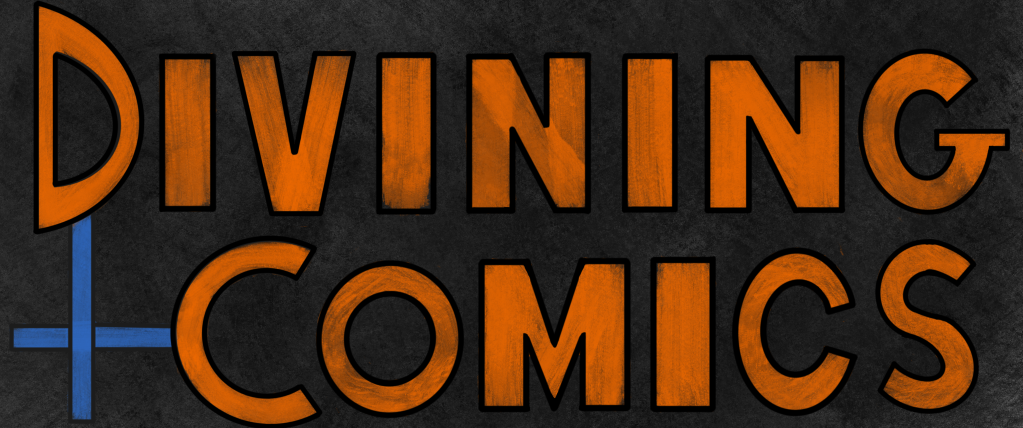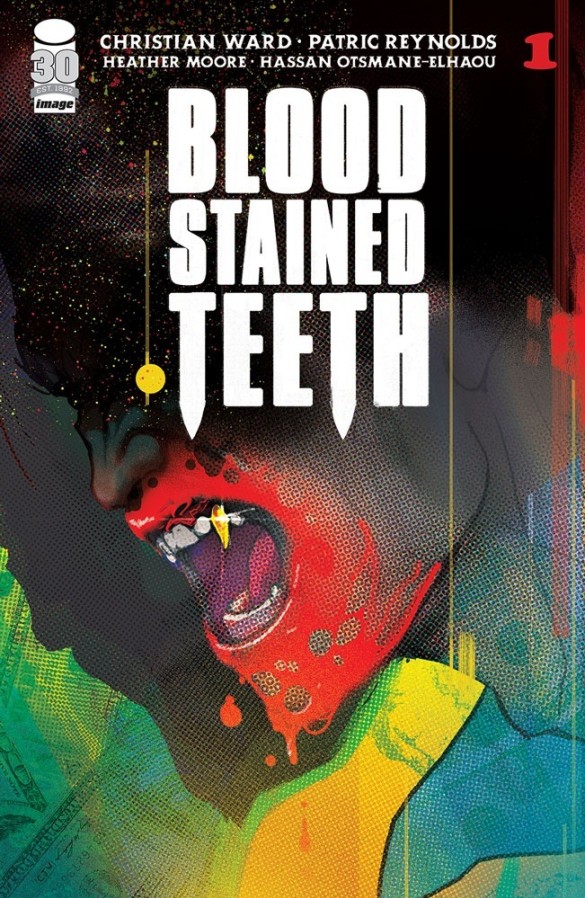Blood Stained Teeth # 1 and Non-Literal Color
In Genesis chapter 30, Jacob, the patriarch later known as Israel, performs what can only be described as color magic. He made a deal with his father in law for all of the sheep that weren’t a single color and instead had spots or stripes. In order to maximize his holdings, Jacob then peels the bark off of trees in order to make them spotted or striped and places them in the watering hole that the best sheep use. Sure enough, when those sheep have children, they are mottled with color. Jacob takes the best sheep home with him.
Color and magic are long-associated. Simply looking at certain colors can change a person’s mood, and while that sounds like magic to me, there is a whole field of psychology that tries to understand that. In comic books, color can accomplish a number of things. I’m going to look at a few of those things by examining issue 1 of Blood Stained Teeth, a vampire comic written by Christian Ward, drawn by Patric Reynolds, lettered by Hassan Otsmane-Elhaou, and, most important for today’s discussion, colored by Heather Moore.
This is the first page. It has three different approaches to color: The emotive, the literal, and the psychedelic. Each one of these accomplishes something different.

Starting with the top tier, this first panel uses emotive coloring. Pop question: what color is the sky? In the world of Blood Stained Teeth, it isn’t blue. That would be too boring. It would communicate a mundanity to this fantastical story. The sky is blue when the weather is nice and everything is alright.

Here, they let the color of the sky communicate something about the emotion of the story. Instead of a nice, baby blue, the sky is a sickly green. It’s the color a cartoon character’s face turns when they are about to be sick. The world of this comic is going to be a bit messed up, and perhaps even a bit horrifying. This first panel, through color, puts the reader in that proper mood.

The second tier of panels is much more literally colored. Sure, the vampire might be a bit paler than a real person. But, the plausible colors here add to the tension of the moment. It makes it feel slightly more real, like if this woman is actually in a bit of danger, and not just a drawing of a woman in a comic book. The shadows do all of the dramatic work here, and you basically accomplish the same effect in black and white.

Finally, you get the psychedelic. These colors are hard to describe in any other terms. They look like waves floating across a body, hitting the vampire’s face like makeup on David Bowie. While potentially not being as scary, this kind of color is a bit unsettling. It’s so non-literal as to feel alien or otherworldly. I will argue that this is not just intentional, it is designed to put you in the headspace of the monstrous. This is vampire-vision. Vampires don’t see the world the same way us humans do.


If you want further proof, you can look directly to a later scene in which Atticus, our lead vampire, chats with his human friend. If you isolate the panels with both of them in frame, things are colored fairly normally. The sky is even blue now! But, now focus on the panels of Atticus and what he is looking at. The colors go neon red and blue. It feels like these panels are colored from a completely different comic! But it associates psychedelia, saturated noir, with the character of Atticus.


The idea of associating a color mood with a character is later picked up with Dr. Beverly Phelps. She is a human with a very recognizable, scientific, and commonplace job. Her world starts out colored literally. But, like in the emotive coloring up top, things change during intense moments. When it is time for intense emotions, her skin turns pink and the yellow-green walls turn blue.


This later page follows the exact same pattern. Realistic colors up top, red face and blue background to depict an intense moment. To be clear, I am not suggesting that the walls in this comic have the ability to change color. Rather, the subjective color they are depicted as can change with the character’s mood. Dr. Phelps might literally see red when she gets mad. She becomes associated with this kind of emotive coloring.

It isn’t a surprise when, at the end of this issue, Dr. Phelps is revealed as the the masked figure that has been following Atticus all issue. Just as he is associated with psychedelic colors, Phelps owns red and blue.

All of this is an abstract look at color. I could have dove further into the meaning of specific colors and what they communicate. If you’d like to know more, I’d recommend checking out If It’s Purple, Someone Is Going to Die by Patti Bellantoni. Knowing what effects the people who color comics are trying to cause will help you continue on your journey of Divining Comics.
If you haven’t already, consider supporting this work at ko-fi.com/spikestonehand. There, you can leave a tip or buy Zine versions of these articles. Doing this helps keep the website going. Follow me on Twitter, Instagram, and Bluesky.


Leave a comment